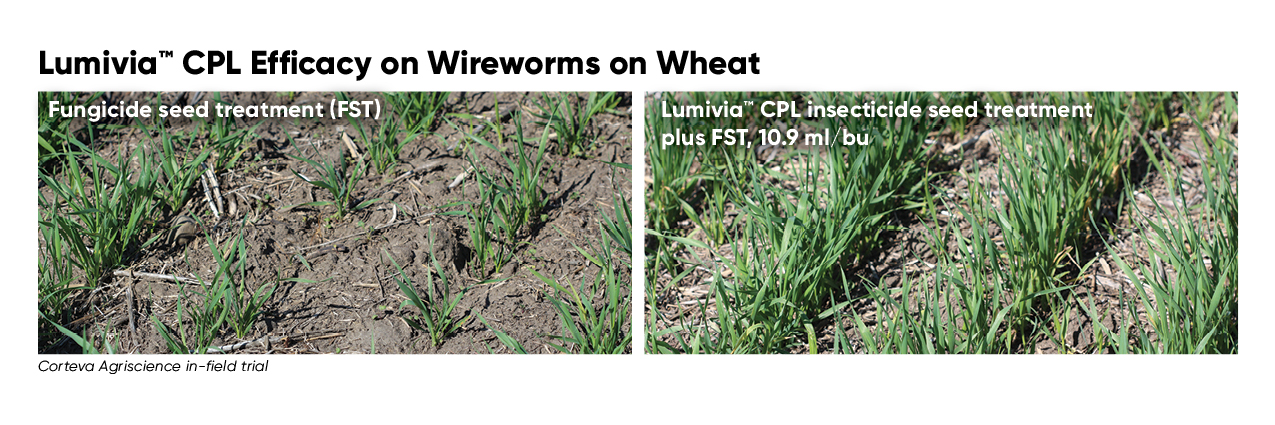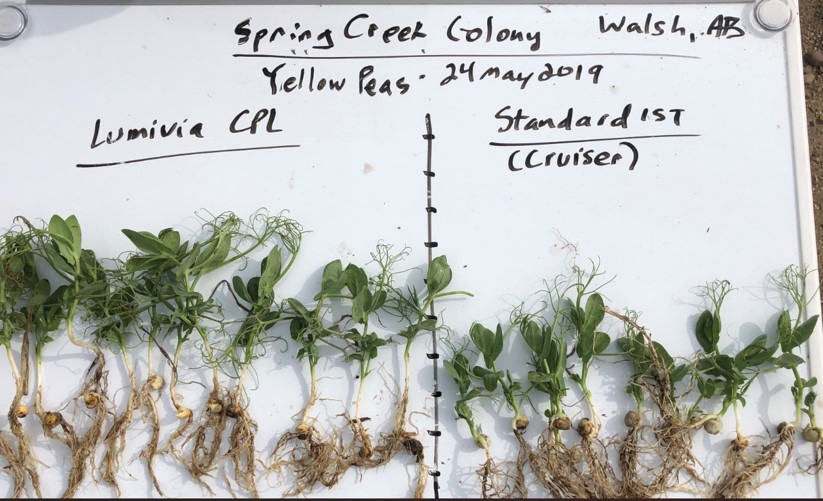Wireworm
Wireworms tend to cause the most damage in cereal crops, though damage has been found in peas and lentils where forage grasses are in the rotation. Wireworms feed early in the season below ground on seeds, shoots and roots causing death or weakening the plant. When the plant dies, gaps in rows and reduced stands are found. Upon close inspection, wireworm damage looks like shredding rather than the cutting done by cutworms. Wireworms are yellowish-white to reddish in colour, have slender hard bodies and are about an inch long. Wireworms are the larvae of click beetles.

Cutworm
Many different types of cutworms can damage crops. Cutworms are the larvae of moths; the larvae are black, grey or brown and approximately 1.5” in length at maturity.
Cutworms feed on cereals, peas and lentils, depending on the type of cutworm, feeding can be below the ground, at the ground surface or on the leaves of the plant. The cutworm larvae cause damage to the crop. Damage can appear as stand loss with gaps in the stand, wilted and dying plants or leaf area loss. Cutworms often move up the row, so if the loss is below ground and the plants did not emerge, it may look like a germination or equipment issue.

Pea Leaf Weevil
Pea Leaf Weevil is a slender greyish brown insect about 1/4” (5mm) long. It has three light-coloured stripes that run lengthwise down its thorax. The larvae are C shaped when disturbed and a milky white colour with a dark brown head about 1/8”-1/4” long.
As noted in the name, this pest is primarily of concern for field pea growers. Adults feed on leaf margins and growing points of the plant creating a distinct notched appearance, however, the most devastating damage comes from the larvae feeding on the nodules. The nodules fix nitrogen for the plant and a plant that cannot fix nitrogen has reduced growth, yield and the damage to the roots opens the plant to other disease-causing pathogens. It is advised to scout the crop from emergence to the sixth node stage. For pea leaf weevils, over the top insecticide treatments are generally ineffective at protecting yield and are only used as a rescue treatment. The most effective option for control is an insecticide seed treatment.

Planning your defence against early-season pests
Timely scouting is often difficult during seeding season and over the top insecticide sprays can be ineffective or unavailable. The most effective option for control is a seed treatment like Lumivia™ CPL insecticide seed treatment from Corteva Agriscience. Lumivia CPL insecticide seed treatment provides outstanding early-season protection against wireworm, cutworm, and pea leaf weevil and offers a favourable environmental profile. With a unique mode of action, it works quickly to stop insect feeding and is the only seed treatment available that controls cutworms. Lumivia CPL is proven to maximize early season seedling stand establishment, increase plant count, maximize yield, and manage risk from insects.
Learn more at lumiviaCPL.corteva.ca and talk to your crop protection retailer about buying Lumivia CPL today.








